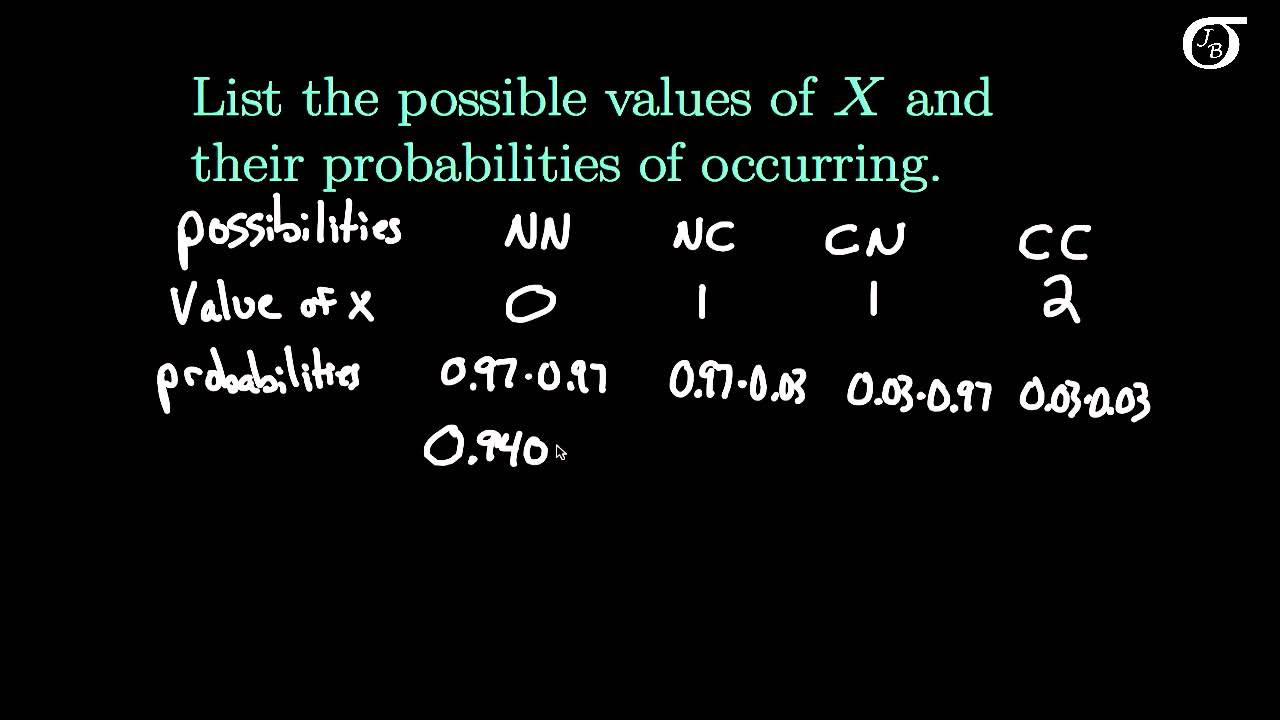Random variables | Probability and Statistics | Khan Academy
TLDRThis video script delves into the concept of random variables, explaining that they are not traditional variables but mappings of random process outcomes to numbers. The speaker illustrates this with examples, such as defining a random variable X to be 1 for heads and 0 for tails when flipping a coin, and another variable Y for the sum of rolling seven dice. The purpose of random variables is to quantify outcomes, allowing for cleaner mathematical notation and analysis in probability. The script also contrasts random variables with traditional algebraic variables, emphasizing that random variables can take on many values with different probabilities, making it more relevant to discuss their probabilities rather than assigning fixed values.
Takeaways
- 🔢 Random variables are used to map outcomes of random processes to numbers, allowing for quantification of those outcomes.
- 🎲 The concept of a random variable is different from traditional variables in algebra, which are assigned specific values or solved for.
- 🎯 Random variables are denoted by capital letters and can take on many different values, each with its own probability.
- 🎯️ An example of a random variable is capital X, which equals 1 for heads and 0 for tails when flipping a fair die.
- 📊 Another example is capital Y, which equals the sum of the upward faces after rolling 7 dice, quantifying the outcome of this random process.
- 🧩 Defining random variables simplifies the mathematical notation and makes it easier to perform calculations on the outcomes of random processes.
- 📉 The usefulness of random variables becomes more apparent when studying probability, as it allows for cleaner mathematical expressions.
- 🤔 The script prompts the viewer to consider why random variables are useful, suggesting that they enable more complex mathematical analysis of outcomes.
- 📚 The video script is an educational resource explaining the concept of random variables in the context of probability theory.
- 🔍 The script emphasizes the distinction between random variables and traditional algebraic variables, highlighting the probabilistic nature of random variables.
- 🚀 The next video in the series will continue the discussion on random variables, potentially exploring different types and their applications.
Q & A
What is a random variable?
-A random variable is a way to map outcomes of random processes to numbers. It is used to quantify the outcomes of events such as flipping a coin, rolling dice, or measuring rainfall.
Why are random variables different from traditional variables in algebra?
-Traditional variables can be assigned specific values or solved for, whereas random variables can take on many different values, each with its own probability. Random variables are used to discuss the likelihood of outcomes rather than specific values.
How is a random variable denoted in mathematical notation?
-Random variables are typically denoted by capital letters, such as capital X or capital Y, to distinguish them from traditional variables which are usually denoted by lowercase letters.
Can you give an example of defining a random variable for a coin flip?
-In the script, a random variable capital X is defined as equal to 1 if the coin flip results in heads, and 0 if it results in tails.
What is another example of a random variable mentioned in the script?
-Another example given is defining a random variable capital Y as the sum of the upward faces after rolling 7 dice.
Why is quantifying outcomes of a random process useful?
-Quantifying outcomes allows for the application of mathematical notation and methods to analyze the probabilities and properties of those outcomes more easily.
How does defining a random variable simplify the notation for probability calculations?
-Instead of writing out the entire scenario each time, such as the sum of the upward faces after rolling seven dice, you can simply refer to the random variable, like capital Y, and state the probability that Y is less than or equal to 30 or that Y is even.
What is the purpose of defining random variables in probability theory?
-The purpose of defining random variables is to facilitate the mathematical analysis of random processes by providing a concise way to represent and calculate probabilities of different outcomes.
What is the difference between assigning a value to a traditional variable and a random variable?
-Assigning a value to a traditional variable means setting it to a specific number, such as x = 1. In contrast, a random variable does not have a fixed value but rather takes on values according to a probability distribution.
How does the concept of random variables help in understanding complex probability problems?
-Random variables help in understanding complex probability problems by providing a systematic way to represent and analyze the outcomes of random processes, making it easier to apply mathematical techniques to find probabilities and other statistical measures.
Outlines
🎲 Understanding Random Variables
The video introduces the concept of random variables, which are often misunderstood as traditional variables from algebra. Instead, random variables serve as a mapping tool to assign numerical values to outcomes of random processes, such as flipping a coin or rolling dice. The video provides an example by defining a random variable 'X' that equals 1 for heads and 0 for tails when flipping a fair die. It emphasizes the flexibility in defining random variables and contrasts them with traditional variables where values can be assigned or solved for. The purpose of random variables is to facilitate mathematical analysis and probability calculations, as demonstrated by simplifying the notation for probability questions involving random processes.
📊 The Nature of Random Variables
This paragraph delves into the characteristics of random variables, highlighting that they can assume numerous values, each with its own probability. It explains that discussing the probability of a random variable taking on a specific value, being less than or greater than a certain number, or possessing a particular property is more appropriate than with traditional variables. The video promises to continue the discussion in the next installment, where different types of random variables will be explored.
Mindmap
Keywords
💡Random Variable
💡Mapping Outcomes
💡Quantifying Outcomes
💡Probability
💡Algebraic Variables
💡Traditional Variables
💡Assigning Values
💡Flipping a Coin
💡Rolling Dice
💡Sum of Rolls
💡Mathematical Notation
Highlights
Introduction to the concept of a random variable.
Random variables are not traditional variables but a way to map outcomes of random processes to numbers.
Examples of random variables include mapping the outcomes of a coin flip or a die roll.
Random variables are typically denoted by capital letters.
Defining a random variable X as 1 for heads and 0 for tails in a coin flip.
Alternative definitions for random variables can be arbitrary numbers but should be meaningful.
Random variables can quantify outcomes, simplifying the mathematical analysis of random processes.
Defining a random variable Y as the sum of the upward faces after rolling seven dice.
Quantifying outcomes allows for cleaner mathematical notation and probability calculations.
Random variables enable the calculation of probabilities for specific outcomes or properties.
Difference between traditional variables and random variables in terms of assignment and solving.
Random variables can take on many values with different probabilities.
Random variables are used to discuss probabilities of equaling a value or having certain properties.
Upcoming discussion on the types of random variables in the next video.
Transcripts
Browse More Related Video

02 - Random Variables and Discrete Probability Distributions

5.1.1 Discrete Probability Distributions - Discrete and Continuous Random Variables

Introduction to Discrete Random Variables and Discrete Probability Distributions

Probability Theory 10 | Random Variables

Constructing a probability distribution for random variable | Khan Academy

5. Discrete Random Variables I
5.0 / 5 (0 votes)
Thanks for rating: